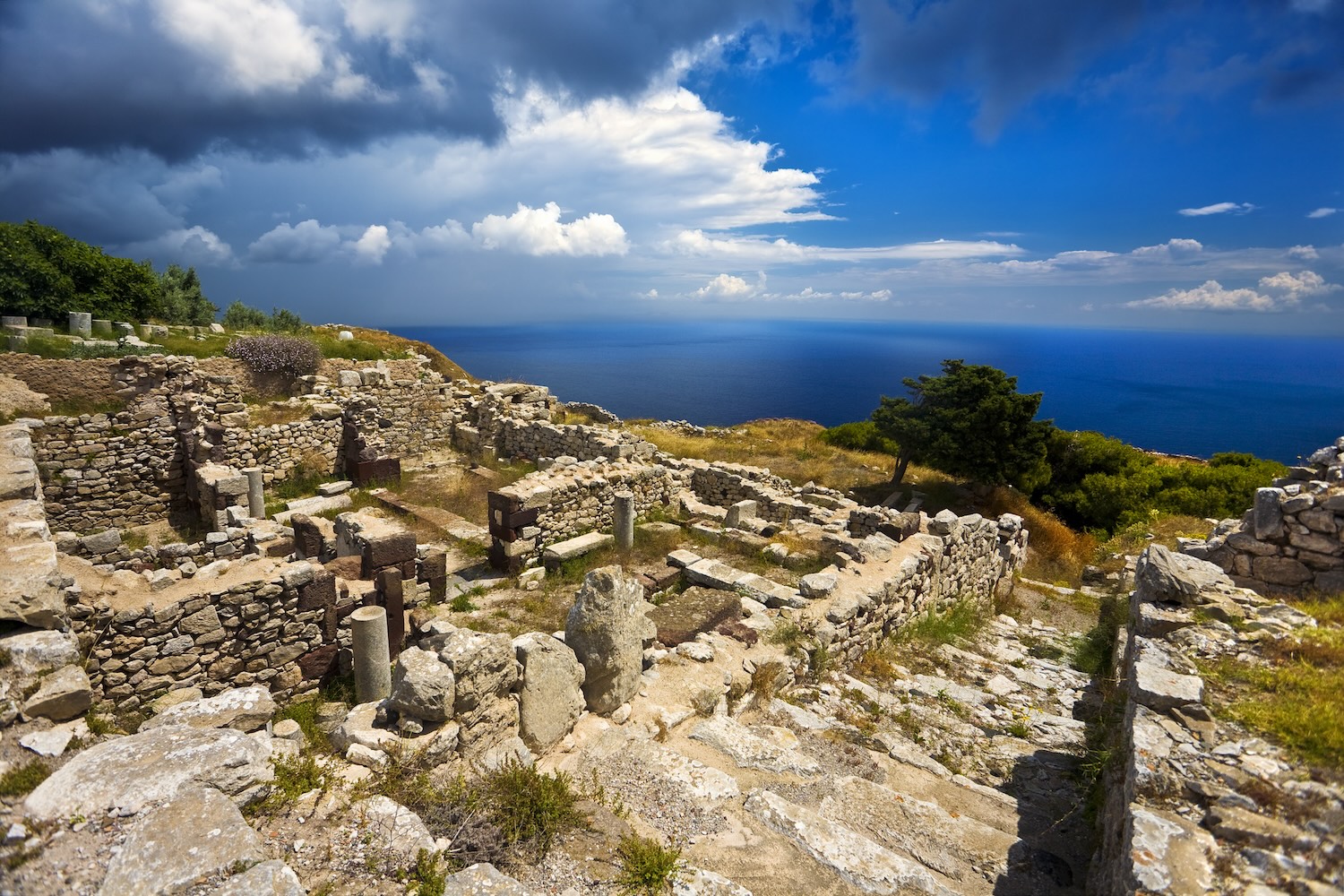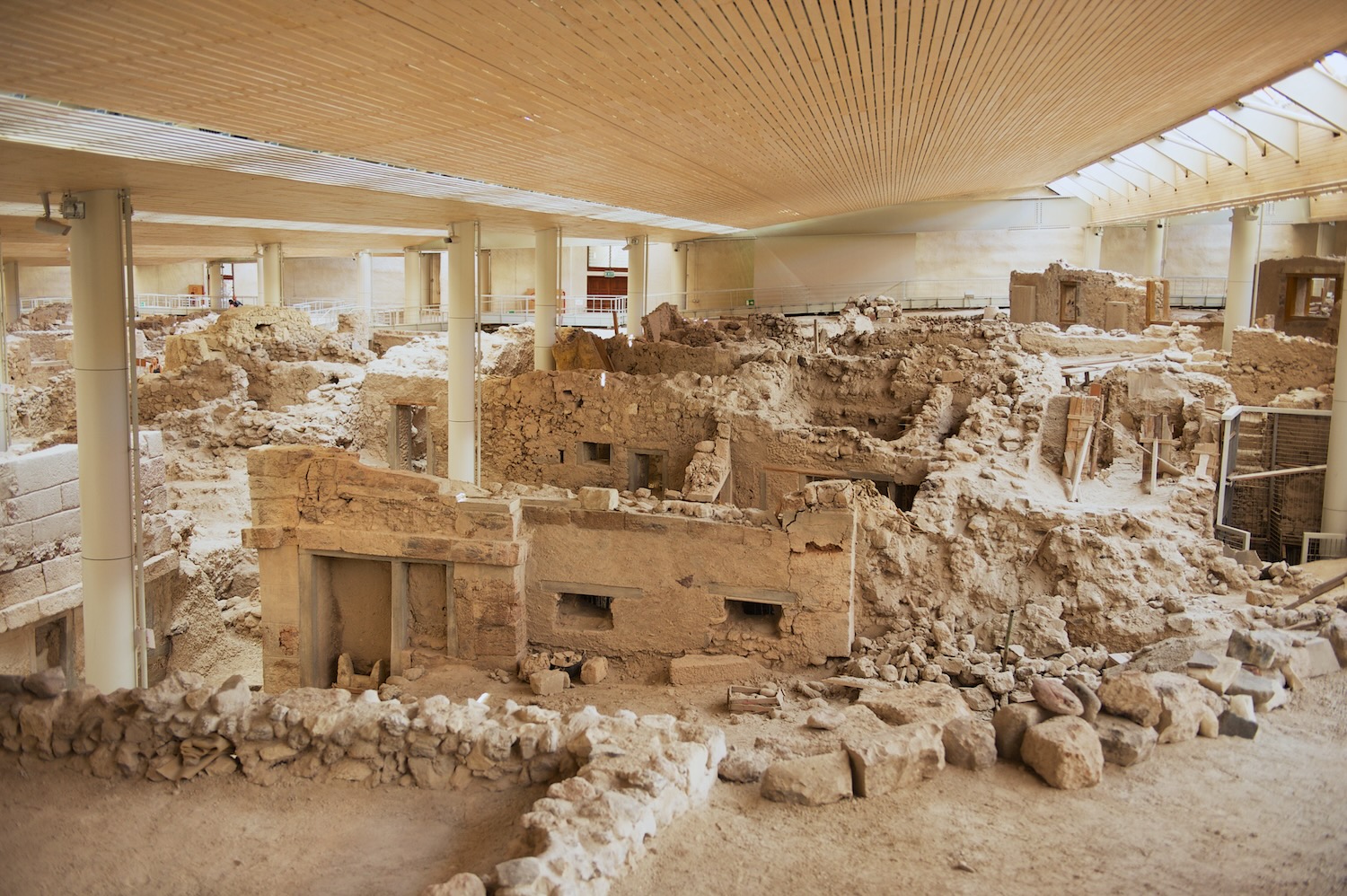






What remains today is chiefly a water-filled caldera. The name Santorini was given it by the Latin empire in the thirteenth century, and is a reference to Saint Irene. Before then it was named Kallist? (“the most beautiful one”), Strongyl? (“the circular one”), or Thera.
The island is the site of one of the largest volcanic eruptions the planet has ever seen: the Minoan eruption, (sometimes called the Thera eruption), which occurred some 3,500 years ago at the height of the Minoan civilization. The eruption left a large caldera surrounded by volcanic ash deposits hundreds of feet deep and may have led indirectly to the collapse of the Minoan civilization on the island of Crete, 110 km (70 miles) to the south, through the creation of a gigantic tsunami. Another popular theory holds that the Thera eruption is the source of the legend of mythic Atlantis.
Excavations starting in 1967 at the site called Akrotiri (“Upper Thira”) under the late Professor Sp. Marinatos have made Thera the best-known “Minoan” site outside of Crete, the homeland of the culture. The island was not called Thera at the time.
Only the southern tip of a large town has been uncovered, yet it has revealed complexes of multi-level buildings, streets, and squares with remains of walls standing as high as eight meters, all entombed in the solidified ash of the famous eruption of Thera.
The site was not a palace-complex such as are found in Crete, but its excellent masonry and fine wall-paintings show that this was certainly no conglomeration of merchants’ warehousing either. A loom-workshop suggests organized textile weaving for export. This Bronze Age civilization thrived between 3000 to 2000 BC, and reached its peak in the period 2000 to 1580 BC.

In Akrotiri was a Minoan town of the 16th century BC, and found a Bronze Age town of some 30.000 inhabitants. Volcanic ash has preserved two and three-story buildings with walls decorated by Minoan paintings. No skeletons, precious jewelry or gold have been found in Akrotiri, indicating that the residents must have been prewarned of the catastrophe, probably by earth tremors. After the great eruption, which destroyed what civilization was found on the island, Santorini remained uninhabited for a long time.
The ruins of ancient Thira, excavated at the turn of the century by German archaeologists, have tombs and inscriptions that indicate that the capital of the Dorian colonists was situated there from the ninth century BC. The Ptolemy’s set up an important garrison here to keep watch over the archipelago. During the eighth century BC a Theban hero, Thiras, left Sparta where he was reigning and brought a group of noblemen with him to settle in Santorini. The island was subsequently called after him, Thira, and is known by that name officially ever since.
Herodotus writes that Santorini had seven towns during that period and was governed by King Grinnas, who upon the advice of the oracle at Delphi sent an expedition to Cyrene in Africa where many Thirans settled and prospered. During the Persian wars, Thirans were on the side of the conquerors and in 476 BC refused to join the Athenian alliance as they considered themselves Dorians. Santorini joined the tributary of Athens, however, a short time later and was forced to pay five talands (ancient Greek currency) as a tribute. Not satisfied with the Athenians, the Thirans then submitted to the Spartan sovereignty and obtained independence only with the Antalkidios pact. However, this independence was not totally respected by the Sparta.
Pipes with running water and water closets found at Akrotiri are the oldest such utilities discovered. The pipes run in twin systems, indicating that the Therans used both hot and cold water supplies; the origin of the hot water probably was geothermic, given the volcano’s proximity. The dual pipe system suggesting hot and cold running water, the advanced architecture, and the apparent layout of the Akrotiri find resemble Plato’s description of the legendary lost city of Atlantis, further indicating the Minoans as the culture which primarily inspired the Atlantis legend.

Volcano probably admonished the islanders, so that escape by boats with all prcious items…but..they have been lost..
The gold shamoi(unic precious item) demonstrate the hight level of culture and art in Akrotiri town.
Fragmentary wall-paintings at Akrotiri lack the insistent religious or mythological content familiar in both Classical Greek and Christian decor. Instead, the Minoan frescoes depict “Saffron-Gatherers”, who offer their crocus-stamens to a seated lady, perhaps a goddess.
In another house are two antelopes, painted with a kind of confident, flowing, decorative, calligraphic line, the famous fresco of a fisherman with his double strings of fish strung by their gills, and the flotilla of pleasure boats, accompanied by leaping dolphins, where ladies take their ease in the shade of light canopies, among other frescoes. We can understand, from the 41 frescoes, the hight level of the life in that period.
Many archeologists believe that this exellent place inspired Platon to speak about The mythic Atlandis!
Ancient Thera, the Classical city of the island is located on Mesa Vouno, 396 m. above sea level. It was founded in the end of 12th century B.C. by Dorian colonists whose leader was Theras, and continued to be inhabited until the early Byzantine period. That is why the island named Thira. The preserved ruins belong to the Hellenistic and Roman phases of the city. The residential area and the larger part of the cemeteries were excavated by German archaeologists between 1895 and 1902. The cemeteries on the NE and NW slopes of Sellada were excavated by N. Zapheiropoulos in the years 1961-1982. A visit in Ancient Thira, is very interesting!
The island was first mentioned as Santorini by the Arab geographer Edizi in one of his journeys in the Cyclades in 1153. The name derives from the island’s church of St. Irene. Foreign seamen used to call the saint, Santa Irini, and in the course of time this became Santorini. Santorini came under the sway of Venice during the Byzantine period ending in 1204. It was handed over to the dukes of Naxos along with 17 other islands in 1207. In 1269 the Byzantine Greeks reconquered Santorini but in 1296 the Venetians took over the rule of the island. A dreadful volcanic eruption submerged half of Palia Kameni in 1452 and the islanders suffered hardships from the constant attacks by pirates who helped dwindle Santorini’s population to just 300.
When the Catholics settled on the island, they exerted an influence over the residents and founded educational institutes and a local civilization flourished once again. In 1537 the Moslem pirate Barbarossa, with the help of the Sultan of Turkey, terrorized the Cyclades islands and ceded Santorini to the Turks. Under Turks, islanders create a big nautical power. The islanders gained their independence in 1821. Captain Evangelos Matzarakis raised theflag of liberty on the island on May 5 of that year. In World War II the Italians and Germans occupied Santorini until October 18, 1944. One more big interruption of the Vocano, and the earthquake in 1956, coused death and destuction on the island. Most of people, panickly, escape to Pireo.
During that period, Santorini attracted the interest of many scientists, historians, geologists, archeologists, and architects that starts the rinovation of the caves (1970) So slowly was lifted back to cener stage. The islanders, after a big economical crisis, took to the turism. There are still some (a few) caves that need reconstruction. But 25 years ago, almost in all cliffs appeared this image. Wild caves… That in the interior are nearly untouched. Every cave is one house that is waiting for its new owner, to reconsruct it, to give it life again…

As the Ifestio Villas its new era a series of services and amenities are now available for its new “Santorinian” guests to enjoy; great offers, upgraded services, and above all simple and easy direct booking through our website!
The Ifestio Villas people will help you through all the details of your reservation, inform you about distances and transfers to and from the hotel and answer all the questions regarding your stay and getting around in Santorini.
The new era of Santorini Ifestio Villas is an experience that starts as soon as you book directly through our website!


